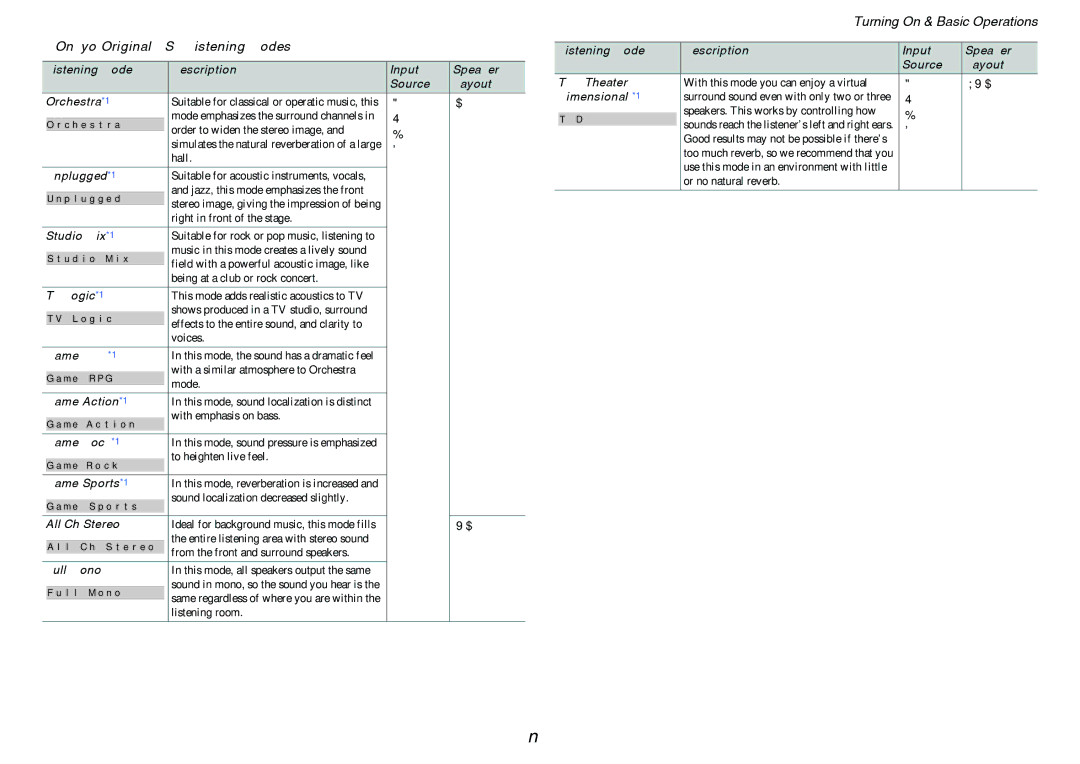■Onkyo-Original DSP Listening Modes
Listening Mode | Description | Input | Speaker | ||||
|
|
|
|
|
| Source | Layout |
Orchestra*1 | Suitable for classical or operatic music, this | A | C | ||||
|
|
|
|
| mode emphasizes the surround channels in | S |
|
| O r c h e s t r a |
|
|
| |||
|
|
| order to widen the stereo image, and | D |
| ||
|
|
|
|
|
| ||
|
|
|
|
| simulates the natural reverberation of a large |
| |
|
|
|
|
| F |
| |
|
|
|
|
| hall. |
|
|
Unplugged*1 | Suitable for acoustic instruments, vocals, |
|
| ||||
|
|
|
|
| and jazz, this mode emphasizes the front |
|
|
| U n p l u g g e d |
|
|
|
| ||
|
|
| stereo image, giving the impression of being |
|
| ||
|
|
|
|
|
|
| |
|
|
|
|
| right in front of the stage. |
|
|
|
|
|
|
|
|
| |
| Suitable for rock or pop music, listening to |
|
| ||||
|
|
|
|
| music in this mode creates a lively sound |
|
|
| S t u d i o – M i x |
|
|
|
| ||
|
|
| field with a powerful acoustic image, like |
|
| ||
|
|
|
|
|
|
| |
|
|
|
|
| being at a club or rock concert. |
|
|
|
|
|
|
|
|
| |
TV Logic*1 | This mode adds realistic acoustics to TV |
|
| ||||
|
|
|
|
| shows produced in a TV studio, surround |
|
|
| T V | L o g i c |
|
|
|
| |
|
|
| effects to the entire sound, and clarity to |
|
| ||
|
|
|
|
|
|
| |
|
|
|
|
| voices. |
|
|
|
|
|
|
|
|
| |
| In this mode, the sound has a dramatic feel |
|
| ||||
|
|
|
|
| with a similar atmosphere to Orchestra |
|
|
| G a m e – R P G |
|
|
|
| ||
|
|
| mode. |
|
| ||
|
|
|
|
|
|
| |
|
|
|
|
|
|
| |
In this mode, sound localization is distinct |
|
| |||||
|
|
|
|
| with emphasis on bass. |
|
|
| G a m e – A c t i o n |
|
|
|
| ||
|
|
|
|
|
| ||
|
|
|
|
|
|
|
|
In this mode, sound pressure is emphasized |
|
| |||||
|
|
|
|
| to heighten live feel. |
|
|
| G a m e – R o c k |
|
|
|
| ||
|
|
|
|
|
| ||
|
|
|
|
|
|
|
|
In this mode, reverberation is increased and |
|
| |||||
|
|
|
|
| sound localization decreased slightly. |
|
|
| G a m e – S p o r t s |
|
|
|
| ||
|
|
|
|
| |||
|
|
|
|
|
|
|
|
All Ch Stereo | Ideal for background music, this mode fills |
| XC | ||||
|
|
|
|
| the entire listening area with stereo sound |
|
|
| A l l C h S t e r e o |
|
|
|
| ||
|
| from the front and surround speakers. |
|
| |||
|
|
|
|
|
|
| |
|
|
|
|
|
|
| |
Full Mono | In this mode, all speakers output the same |
|
| ||||
|
|
|
|
| sound in mono, so the sound you hear is the |
|
|
| F u l | l M o n o |
|
|
|
| |
|
| same regardless of where you are within the |
|
| |||
|
|
|
|
|
|
| |
|
|
|
|
| listening room. |
|
|
|
|
|
|
|
|
|
|
Turning On & Basic Operations
Listening Mode | Description | Input | Speaker | ||
|
|
|
| Source | Layout |
With this mode you can enjoy a virtual | A | ZXC | |||
Dimensional)*1 | surround sound even with only two or three | S |
| ||
|
| speakers. This works by controlling how | D |
| |
| T – D |
|
| ||
|
|
| sounds reach the listener’s left and right ears. | F |
|
|
|
|
| ||
|
|
| Good results may not be possible if there’s |
| |
|
|
| too much reverb, so we recommend that you |
|
|
|
|
| use this mode in an environment with little |
|
|
|
|
| or no natural reverb. |
|
|
|
|
|
|
|
|
